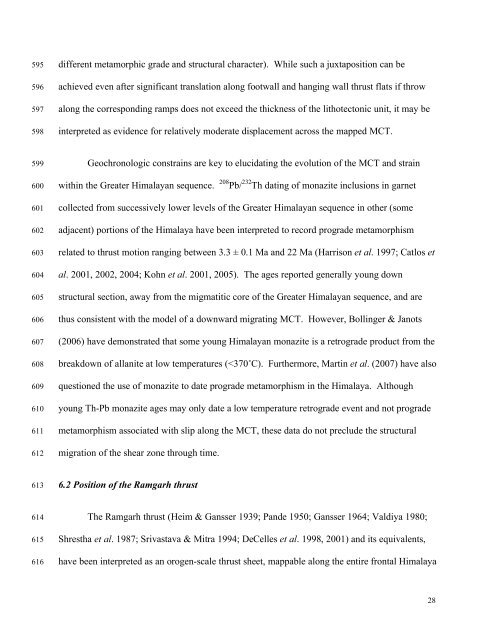Kinematics of the Greater Himalayan sequence, Dhaulagiri Himal ...
Kinematics of the Greater Himalayan sequence, Dhaulagiri Himal ...
Kinematics of the Greater Himalayan sequence, Dhaulagiri Himal ...
Create successful ePaper yourself
Turn your PDF publications into a flip-book with our unique Google optimized e-Paper software.
595<br />
596<br />
597<br />
598<br />
different metamorphic grade and structural character). While such a juxtaposition can be<br />
achieved even after significant translation along footwall and hanging wall thrust flats if throw<br />
along <strong>the</strong> corresponding ramps does not exceed <strong>the</strong> thickness <strong>of</strong> <strong>the</strong> lithotectonic unit, it may be<br />
interpreted as evidence for relatively moderate displacement across <strong>the</strong> mapped MCT.<br />
599<br />
600<br />
601<br />
602<br />
603<br />
604<br />
605<br />
606<br />
607<br />
608<br />
609<br />
610<br />
611<br />
612<br />
Geochronologic constrains are key to elucidating <strong>the</strong> evolution <strong>of</strong> <strong>the</strong> MCT and strain<br />
within <strong>the</strong> <strong>Greater</strong> <strong><strong>Himal</strong>ayan</strong> <strong>sequence</strong>. 208 Pb/ 232 Th dating <strong>of</strong> monazite inclusions in garnet<br />
collected from successively lower levels <strong>of</strong> <strong>the</strong> <strong>Greater</strong> <strong><strong>Himal</strong>ayan</strong> <strong>sequence</strong> in o<strong>the</strong>r (some<br />
adjacent) portions <strong>of</strong> <strong>the</strong> <strong>Himal</strong>aya have been interpreted to record prograde metamorphism<br />
related to thrust motion ranging between 3.3 ± 0.1 Ma and 22 Ma (Harrison et al. 1997; Catlos et<br />
al. 2001, 2002, 2004; Kohn et al. 2001, 2005). The ages reported generally young down<br />
structural section, away from <strong>the</strong> migmatitic core <strong>of</strong> <strong>the</strong> <strong>Greater</strong> <strong><strong>Himal</strong>ayan</strong> <strong>sequence</strong>, and are<br />
thus consistent with <strong>the</strong> model <strong>of</strong> a downward migrating MCT. However, Bollinger & Janots<br />
(2006) have demonstrated that some young <strong><strong>Himal</strong>ayan</strong> monazite is a retrograde product from <strong>the</strong><br />
breakdown <strong>of</strong> allanite at low temperatures (

















